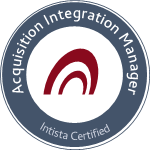
Finance in Integrations
Estimate costs, submit your budget, and track synergies
This course is also part of the Certified Acquisition Integration Manager program
In this course we learn how to estimate, budget the finances of an integration. We will address three types of cost estimation, budget submission and three types of synergy savings.
Note that different size businesses will apply different amounts of finance rigor to an integration. Generally smaller integrations are managed less, and large integrations manage finances more closely. Every size integration should apply some level of financial management. In this learning, we address the spectrum of needs for lower-mid and mid-size acquisition integrations.
How are you currently measuring your integrations?
Learn three types of cost estimation and synergy tracking that apply to lower-mid and mid-size integrations
Finance in Integrations covers the following topics
- Planned cost estimations
- Unplanned event cost estimation
- What are intangible costs, and how to estimate them
- Synergy types, and how they apply to smaller integration
- How to seek out all possible synergies
It is important that every size integration applies some financial management. In this learning, we address the spectrum of needs for lower-mid and mid-size acquisition integrations.
Check out the contents of this course!

Upon successfully passing the course assessment, you will be awarded a Learning Achievement for completion. It contributes towards the Certified Acquisition Integration Manager (CAIM) qualification. To review your Learning Achievements go to Online, My Learning Profile
To review your Learning Achievements go to Online, My Learning Profile
Contact us to get a credit!
I loved it: the information, the way that everything is explained. The way that it flows all the way to the end. It is so well explained. It helps you concentrate and guide your process.
Luis Acevedo
Very valuable, I was able to immediately apply a lot of what was taught. I recommend this to anyone tasked with M&A work and leading M&A integration efforts. This course gives step by step relatable information that can be applied right away.
Maidei Burnette
Great course with comprehensive coverage of acquisition integration. A great facilitator kept the content engaging and encouraged robust discussions.
Drew Von Buseck
Intista's Sales Integration Checklist is a great tool to use when bringing two separate teams together, with all its supporting elements in place. There are other tools for merging sales teams, but this is the best there is for mid-size M&A integration. I recommend that you download and use this tool when planning next steps.
Chris Perfect
I used to worry about integration after signing the papers I'd think "What do I do now?". It was a really good program that helped me understand the things that I need to consider to get the most value out of my acquisitions, based upon my acquisition goals. There were a lot of things that I wasn't thinking about.
Andrew Swanscott
It was very valuable. Saving me or an organization involved many times the cost of the class. There was lot of the practical advice that I wish I had had about 12 months ago with an integration that we did.
David Cusimano
The class was comprehensive, and very practical. There's a lot of these that are theoretical and academic, and this is anything but that.
Ed Jurica
I would really recommend [it for] people who are already in the field of M&A Integration, or for those who are interested in pivoting to this field to consider the course. There are a lot of fundamental learnings one can get from this course, [including] the structure, processes, and results of integration...”
Jarvis Luu
The [course] exceeded my expectations. I think we were all 'experienced' coming into the class, but we all walked away with a much better understanding of the process which should help us collaborate better with corporate development on future integration work.
Rich Cone
I highly recommend Intista's integration training. The training is comprehensive, based on years of integration experience and data-backed insight and very relevant to my integration work.
The best thing I learned was an overall framework and process for integrations. From this baseline, I can then adjust based on unique circumstances. But I now have a very good starting point.
Ernie Lopez
The amount of knowledge and wisdom in this course cannot be met by anyone else.
... very responsive and helpful at every point of the course. I felt very supported.
Sarah Thornhill
[Intista] made the platform very easy to follow. The way [it] organizes the content to align with the actual integration process, I think it was very easy to follow. It is a great product that is highly customizable and has the structure that is needed for anyone who [wants to] jump in on it at any time.
Winnie Lee
Exceeded expectations. Substantial spreadsheets and checklists to support integration activity.
Tony Mulvahil
12 Months' Access
Take this course to learn how to cost estimate, budget and measure financial success
Register now to access the course Finance in Integrations
Register with a unique user name and password

















